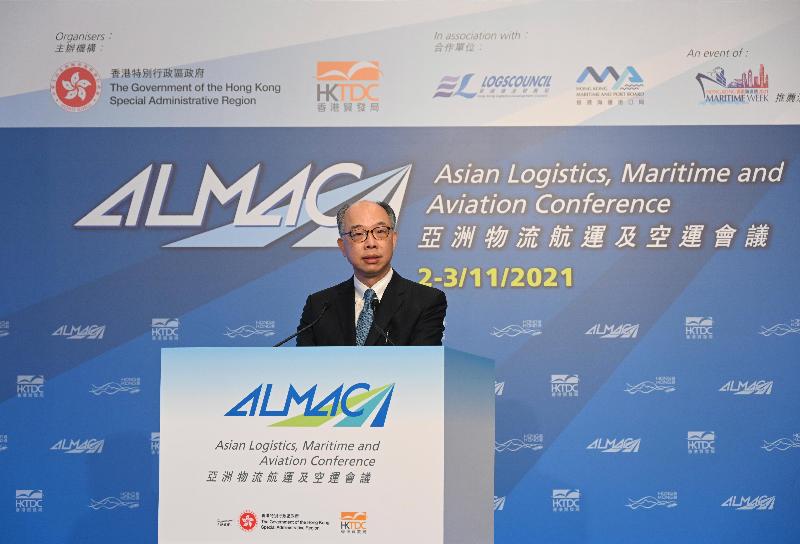Speech by STH at Asian Logistics, Maritime and Aviation Conference 2021 (English only) (with photo)
******************************************************************************************
Margaret (Executive Director of the Hong Kong Trade Development Council, Ms Margaret Fong), distinguished guests, ladies and gentlemen,
ýÿ Good morning. Welcome to the second day of the Asian Logistics, Maritime and Aviation Conference (ALMAC) 2021.
Although there are still two months to go, 2021 is no doubt another challenging year for the logistics industry. The global supply chain has survived and risen to the challenge to keep the world going, from restocking hash browns and chicken wings locally, to the timely distribution of food and other essential supplies such as vaccines worldwide. It calls for collaboration that transcends borders and sectors, and is only made possible through concerted efforts among the maritime, aviation and logistics industries. Given such a backdrop, the theme of this year's Conference, "Resilience, Agility, Sustainability" could not be more timely.
Despite disruptions to global supply chain and worldwide shortage of containers, we have been doing whatever we can to maintain normal operations of our airport and port round the clock. For the first nine months of 2021, the cumulative container throughput at the Hong Kong Port has edged up to 13.3 million TEUs and cargo throughput at the Hong Kong International Airport recorded a 13.1 per cent growth to 3.6 million tonnes. These are testimony that cargo operations on all fronts in Hong Kong remain vibrant and resilient.
Under "One Country, Two Systems", the National 14th Five-Year Plan reaffirms the unwavering support of the Central People's Government to strengthen Hong Kong's position as international aviation hub and international maritime centre, as well as the region's logistics hub.
The Guangdong-Hong Kong-Macao Greater Bay Area is one of the fastest growing regions in China and in the world, with a total population of 86 million and a combined GDP of around US$1.7 trillion. The strategic development of the Greater Bay Area provides immense opportunities for common prosperity. Last year, the Greater Bay Area handled altogether a throughput of 82 million TEUs, and 7.7 million tonnes of air mails and cargoes. Putting together the nation's dual circulation economic development strategy, the Greater Bay Area's cluster effect, and the Regional Comprehensive Economic Partnership, the potential for development and growth for the logistics, maritime and aviation industries would be phenomenal.
To make the most of these opportunities, we have formulated comprehensive strategies to reinforce our position as a premier regional logistics hub, underpinned by our world-class transport infrastructures, be it air, land and sea. Our aviation network reach out to over 200 destinations worldwide. The Hong Kong International Airport had been the world's busiest cargo airport for many years, and its cargo handling capacity will be doubled to 10 million tonnes annually when the Three-runway System is fully commissioned by 2024.
As for sea transport, the Hong Kong Port is renowned for its extensive connectivity and efficiency. With over 150 years of maritime heritage, robust international connectivity and our multi-faceted maritime excellence, the Hong Kong Port remains one of the top ten container ports in the world, as well as a transhipment hub in the region. There are some 280 weekly container vessel sailings, connecting to over 600 destinations worldwide.
The future of modern logistics is going to be smart and technology-driven. Automation, artificial intelligence, big data and digitalisation are instrumental. To help achieve this strategic goal, the Government of the Hong Kong Special Administrative Region has set up a HK$300 million funding scheme to encourage logistics services providers in applying technological solutions to enhance productivity.
Apart from hardware and infrastructures, human capital is also indispensable. The Government spares no effort in attracting and grooming talents to support the maritime, aviation and logistics industries. With a total commitment of HK$300 million, the Maritime and Aviation Training Fund has organised a wide spectrum of training activities, with over 13 000 practitioners and students trained over the years. The Hong Kong International Aviation Academy also helps nurture talents for the aviation sector. To better equip for the enormous opportunities brought by the rapid growth of e-commerce in the Mainland and across the globe, the Hong Kong Logistics Association, with the support of the Government, has also launched accredited training programme on cold-chain logistics management.
Ladies and gentlemen, Hong Kong's success in logistics, maritime and aviation has come a long way. The rule of law and level playing field for all, together with multi-modal transport infrastructures and worldwide connectivity, Hong Kong remains the preferred logistic hub in the region. Looking ahead, our continual economic integration with the nation's development will offer unprecedented opportunities for the global community. With the staunch support of the Central People's Government and the enduring collaboration with partners across the globe, we are here to serve with our best, and we count on you, not only to reshape the global supply chain, but also to chart and build an agile, resilient and sustainable system for the future.
In closing, I would like to congratulate the Hong Kong Trade Development Council and the many supporting organisations from home and abroad to make the ALMAC 2021 a resounding success. My heartfelt appreciation also goes to the speakers for sharing with us their thoughts and foresights. I wish you all the best of health and a rewarding conference. Thank you.
Ends/Wednesday, November 3, 2021
Issued at HKT 11:32
Issued at HKT 11:32
NNNN



